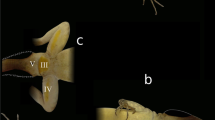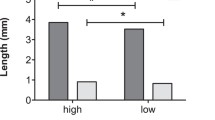Abstract
Aspects of sexual selection were studied in a sexually monomorphic Australian agamid lizard (Ctenophorus fordi), in particular with respect to the sensory exploitation hypothesis. In enclosure trials, females were offered the choice between ‘large’ vs. ‘small’ males and, in a different experiment, males with ‘blue’ vs. ‘normal’ head color. The rationale for these experiments was: firstly, to establish if females actively solicit copulations; secondly, if so, do females solicit copulations non-randomly with respect to male size (because large males may have access to food resources); thirdly, if male coloration is manipulated to match traits of congeneric, conspicuous and sexually dimorphic species, do females show preference for this novel trait (in accordance with the sensory exploitation hypothesis). The corresponding manipulations were also made in a free-living population where the distribution of females on the home ranges of color-manipulated males were monitored. Blue-headed males were accepted as mating partners both in the staged mating trials and in the natural population. Females appeared not to express any kind of active or passive mate choice (rejection); in only one out of 62 trials did a female approach a male herself rather than being approached by the male(s). There was no discrimination against any male category regardless of size or color within a female's receptive period and the manipulation of male head color in the natural population did not result in spatial re-distribution of females. Thus, a female appears to mate unselectively within her receptive period. Rejection behaviors were used only outside of the receptive period to communicate, to all males, that the female is not receptive.
Similar content being viewed by others
References
Andersson, M. (1994) Sexual Selection. Princeton University Press, New Jersey.
Baird, T.A., Fox, S.F. and McCoy, J.K. (1997) Population differences in the roles of size and coloration in intra-and inter-sexual selection the collared lizard, Crotaphytus collaris: influence of habitat and social organization. Behav. Ecol. 8, 506-517.
Birkhead, T.R. and Møller, A.P. (1998) Sperm Competition and Sexual Selection. Academic Press, London.
Carpenter, C.C. and Ferguson, G.W. (1977) Variation and evolution of stereotyped behavior in reptiles. In: C. Gans and D.W. Tinkle (eds). Biology of the Reptilia, Vol. 7 -- Ecology and Behavior. Academic Press, London, pp. 335-554.
Cogger, H.C. (1974) Thermal relations of the Mallee dragon Amphibolorus fordi (Lacertilia: Agamidae). Aus. J. Zool. 22, 319-339.
Cogger, H.C. (1978) Reproductive cycles, fat body cycles and socio-sexual behavior in the Mallee dragon Amphibolorus fordi (Lacertilia: Agamidae). Aus. J. Zool. 26, 653-672.
Cooper, W.E. Jr. (1989) Absence of prey odor discrimination in agamid and iguanid lizards in applicator tests. Copeia 1989, 472-478.
Cooper, W.E. Jr. and Vitt, L.J. (1993) Female mate choice of large broad-headed skinks. Anim. Behav. 45, 683-693.
Eberhard, W.G. (1996) Female Control: Sexual Selection by Cryptic Female Choice. Princeton University Press, Princeton.
Hews, D.K. (1993) Food resources affect female distribution and male mating opportunities in the iguanian lizard Uta palmeri. Anim. Behav. 46, 279-291.
Holland, B. and Rice, W.R. (1998) Perspective: chase-away sexual selection. Antagonistic seduction versus resistance. Evolution 52, 1-7.
Mitchell, F.J. (1973) Studies on the ecology of the agamid lizard Amphibolurus maculosus (Mitchell). Trans. Roy. Soc. S. Aus. 97, 47-76.
Noble, G.K. and Bradley, H.T. (1933) The mating behavior in lizards; its bearing on the theory of sexual selection. Ann. N. Y. Acad. Sci. 25 July, 25-100.
Olson, V.A. and Owens, I.P.F. (1998) Costly sexual signals: are carotenoids rare, risky or required? Trends Ecol. Evol. 13, 510-514.
Olsson, M. (1995) Forced copulation and costly female resistance behavior in the Lake Eyre dragon, Ctenophorus maculosus. Herpetology. 51, 19-24.
Olsson, M. and Madsen, T. (1995) Female choice on male quantitative traits in lizards -- why is it so rare? Behav. Ecol. Sociobiol. 36, 179-184.
Olsson, M. and Madsen, T. (1998) Sexual selection and Sperm competition in Reptiles. In: T.R. Birkhead and A.P. Møller (eds). Sexual Selection and Sperm Competition. Academic Press, London, pp. 503-577.
Ryan, M.J. (1998) Sexual selection, receiver biases, and the evolution of sex differences. Science 281, 1999-2003.
Sinervo, B. and Basolo, A.L. (1996) Testing adaptations using phenotypic manipulations. In: M.R. Rose and G.V. Lauder (eds). Adaptation. Academic Press, London, pp. 149-186.
Stearns, S.C. (1987) Selection arenas. S.C. Stearns (ed). The Evolution of Sex and Its Consequences. Birkhäuser Verlag, Basel, pp. 337-349.
Swiezawska, K. (1949) Color-discrimination of the sand lizard, Lacerta agilis L. Bull. Intern. Acad. Pol. Sci. Lett., Ser. B, Sci. Nat., 1-20.
Thompson, C.W. and Moore, M.C. (1991) Throat color reliably signals status in male tree lizards, Urosaurus ornatus. Anim. Behav. 42, 745-753.
Thompson, C.W., Moore, I.T. and Moore, M.C. (1993) Social, environmental and genetic factors in the ontogeny of phenotypic differentiation in a lizard with alternative male reproductive strategies. Behav. Ecol. Sociobiol. 33, 137-146.
Zucker, N. (1994) A dual status-signalling system: a matter of redundancy or differing roles? Anim. Behav. 47, 15-22.
Author information
Authors and Affiliations
Rights and permissions
About this article
Cite this article
Olsson, M. No female mate choice in Mallee dragon lizards, Ctenophorus fordi . Evolutionary Ecology 15, 129–141 (2001). https://doi.org/10.1023/A:1013865624146
Issue Date:
DOI: https://doi.org/10.1023/A:1013865624146




